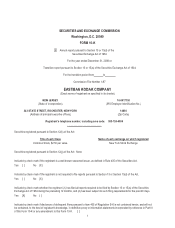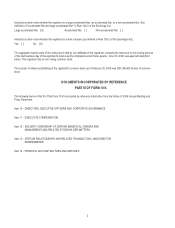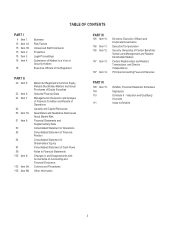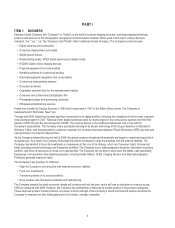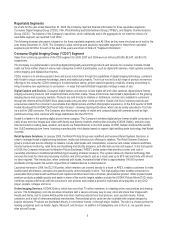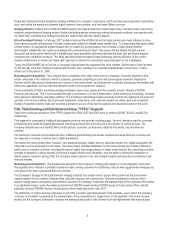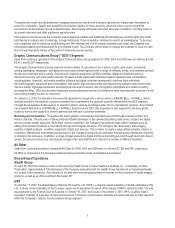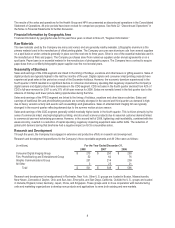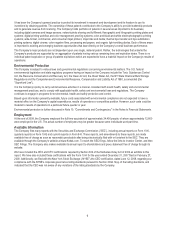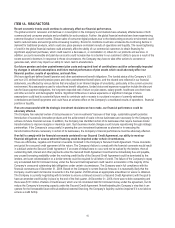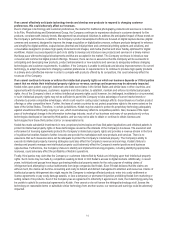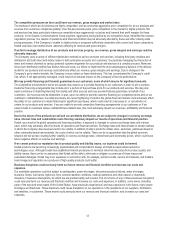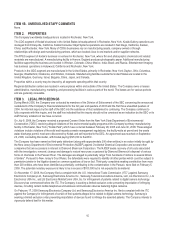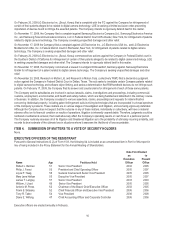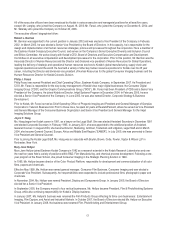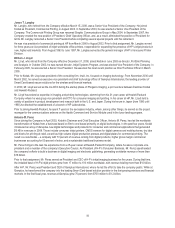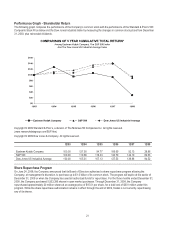Kodak 2008 Annual Report Download - page 13
Download and view the complete annual report
Please find page 13 of the 2008 Kodak annual report below. You can navigate through the pages in the report by either clicking on the pages listed below, or by using the keyword search tool below to find specific information within the annual report.11
If we cannot effectively anticipate technology trends and develop new products to respond to changing customer
preferences, this could adversely affect our revenues.
Due to changes in technology and customer preferences, the market for traditional photography products and services is in decline.
In its Film, Photofinishing and Entertainment Group, the Company continues to experience declines in customer demand for film
products, consistent with industry trends. Management has developed initiatives to address the anticipated impact of these trends on
the Company’s performance. In addition, the Company’s product development efforts are focused on digital capture devices (digital
cameras and scanners) designed to improve the image acquisition or digitalization process, software products designed to enhance
and simplify the digital workflow, output devices (thermal and inkjet printers and commercial printing systems and solutions) and
consumables designed to produce high quality documents and images, and media (thermal and silver halide) optimized for digital
workflows. Kodak’s success depends in part on its ability to develop and introduce new products and services in a timely manner
that keep pace with technological developments and that are accepted in the market. The Company continues to introduce new
consumer and commercial digital product offerings. However, there can be no assurance that the Company will be successful in
anticipating and developing new products, product enhancements or new solutions and services to adequately address changing
technologies and customer requirements. In addition, if the Company is unable to anticipate and develop improvements to its current
technology, to adapt its products to changing customer preferences or requirements or to continue to produce high quality products
in a timely and cost-effective manner in order to compete with products offered by its competitors, this could adversely affect the
revenues of the Company.
If we cannot continue to license or enforce the intellectual property rights on which our business depends or if third parties
assert that we violate their intellectual property rights our revenue, earnings and expenses may be adversely impacted.
Kodak relies upon patent, copyright, trademark and trade secret laws in the United States and similar laws in other countries, and
agreements with its employees, customers, suppliers and other parties, to establish, maintain and enforce its intellectual property
rights. Any of the Company’s direct or indirect intellectual property rights could, however, be challenged, invalidated or circumvented,
or such intellectual property rights may not be sufficient to permit the Company to take advantage of current market trends or
otherwise to provide competitive advantages, which could result in costly product redesign efforts, discontinuance of certain product
offerings or other competitive harm. Further, the laws of certain countries do not protect proprietary rights to the same extent as the
laws of the United States. Therefore, in certain jurisdictions, Kodak may be unable to protect its proprietary technology adequately
against unauthorized third party copying or use, which could adversely affect its competitive position. Also, because of the rapid
pace of technological change in the information technology industry, much of our business and many of our products rely on key
technologies developed or licensed by third parties, and we may not be able to obtain or continue to obtain licenses and
technologies from these third parties at all or on reasonable terms.
Kodak has made substantial investments in new, proprietary technologies and has filed patent applications and obtained patents to
protect its intellectual property rights in these technologies as well as the interests of the Company’s licensees. The execution and
enforcement of licensing agreements protects the Company's intellectual property rights and provides a revenue stream in the form
of royalties that enables Kodak to further innovate and provide the marketplace with new products and services. There is no
assurance that such measures alone will be adequate to protect the Company's intellectual property. The Company’s ability to
execute its intellectual property licensing strategies could also affect the Company’s revenue and earnings. Kodak’s failure to
develop and properly manage new intellectual property could adversely affect the Company’s market positions and business
opportunities. Furthermore, the Company’s failure to identify and implement licensing programs, including identifying appropriate
licensees, could adversely affect the profitability of Kodak’s operations.
Finally, third parties may claim that the Company or customers indemnified by Kodak are infringing upon their intellectual property
rights. Such claims may be made by competitors seeking to block or limit Kodak’s access to digital markets. Additionally, in recent
years, individuals and groups have begun purchasing intellectual property assets for the sole purpose of making claims of
infringement and attempting to extract settlements from large companies like Kodak. Even if Kodak believes that the claims are
without merit, the claims can be time-consuming and costly to defend and distract management’s attention and resources. Claims of
intellectual property infringement also might require the Company to redesign affected products, enter into costly settlement or
license agreements or pay costly damage awards, or face a temporary or permanent injunction prohibiting Kodak from marketing or
selling certain of its products. Even if the Company has an agreement to indemnify it against such costs, the indemnifying party may
be unable to uphold its contractual agreement to Kodak. If we cannot or do not license the infringed technology at all, license the
technology on reasonable terms or substitute similar technology from another source, our revenue and earnings could be adversely
impacted.


